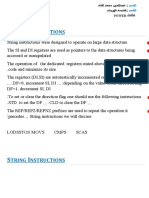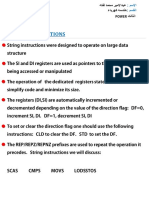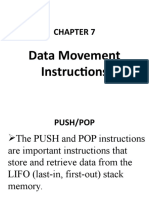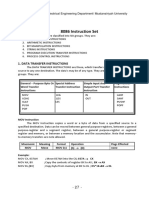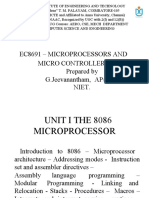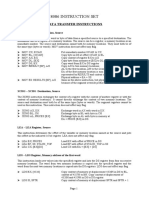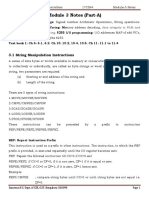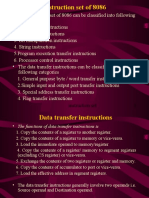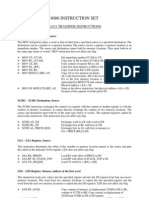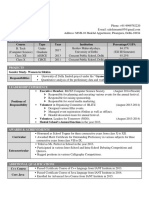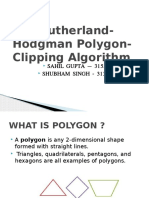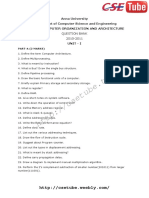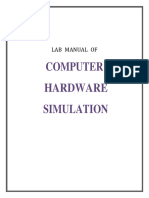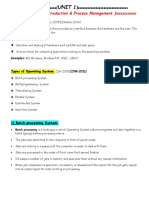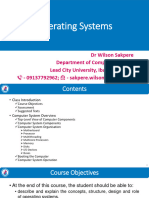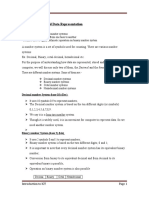STRING
DATA
TRANSFERS
Sahil Gupta
3155
�STRING DATA
TRANSFERS
Five string data transfer instructions: LODS,
STOS, MOVS, INS, and OUTS.
Each allows data transfers as a single byte,
word, or doubleword.
Before the string instructions are presented,
the operation of the D flag-bit (direction), DI,
and SI must be understood as they apply to
the string instructions.
�The Direction Flag
The direction flag (D, located in the flag
register) selects the auto-increment or the
auto-decrement operation for the DI and SI
registers during string operations.
used only with the string instructions
The CLD instruction clears the D flag and
the STD instruction sets it .
CLD instruction selects the auto-increment mode
and STD selects the auto-decrement mode
�DI and SI
During execution of string instruction,
memory accesses occur through DI and SI
registers.
DI offset address accesses data in the extra
segment for all string instructions that use it
SI offset address accesses data by default
in the data segment
Operating in 32-bit mode EDI and ESI
registers are used in place of DI and SI.
this allows string using any memory location in
the entire 4G-byte protected mode address space
�LODS
Loads AL, AX, or EAX with data stored at
data segment offset address indexed by the
SI register.
A 1 is added to or subtracted from SI for a
byte-sized LODS
A 2 is added or subtracted for a word-sized
LODS.
A 4 is added or subtracted for a
doubleword-sized LODS.
Figure 418 shows the LODSW instruction.
�Figure 418The operation of the LODSW instruction if
DS=1000H, D=0,11000H, 11001H = A0. This instruction is
shown after AX is loaded from memory, but before SI
increments by 2.
�STOS
Stores AL, AX, or EAX at the extra segment
memory location addressed by the DI register.
STOSB (stores a byte) stores the byte in AL
at the extra segment memory location
addressed by DI.
STOSW (stores a word) stores AX in the
memory location addressed by DI.
After the byte (AL), word (AX), or doubleword
(EAX) is stored, contents of DI increment or
decrement.
�STOS with a REP
The repeat prefix (REP) is added to any
string data transfer instruction except LODS.
REP prefix causes CX to decrement by 1 each time
the string instruction executes; after CX
decrements, the string instruction repeats
If CX reaches a value of 0, the instruction
terminates and the program continues.
If CX is loaded with 100 and a REP STOSB
instruction executes, the microprocessor
automatically repeats the STOSB 100 times.
�MOVS
Transfers a byte, word, or doubleword a
data segment addressed by SI to extra
segment location addressed by DI.
pointers are incremented or decremented, as
dictated by the direction flag
Only the source operand (SI), located in the
data segment may be overridden so
another segment may be used.
The destination operand (DI) must always
be located in the extra segment.
�INS
Transfers a byte, word, or doubleword of data
from an I/O device into the extra segment
memory location addressed by the DI
register.
I/O address is contained in the DX register
Useful for inputting a block of data from an
external I/O device directly into the memory.
One application transfers data from a disk
drive to memory.
disk drives are often considered and interfaced
as I/O devices in a computer system
�Three basic forms of the INS.
INSB inputs data from an 8-bit I/O device
and stores it in a memory location indexed
by SI.
INSW instruction inputs 16-bit I/O data and
stores it in a word-sized memory location.
INSD instruction inputs a doubleword.
These instructions can be repeated using
the REP prefix
allows an entire block of input data to be stored
in the memory from an I/O device
�OUTS
Transfers a byte, word, or doubleword of
data from the data segment memory
location address by SI to an I/O device.
I/O device addressed by the DX register as with
the INS instruction
In the 64-bit mode for Pentium 4 and Core2,
there is no 64-bit output
but the address in RSI is 64 bits wide
�THANK YOU


